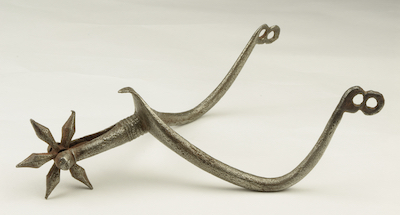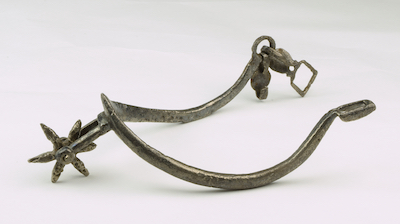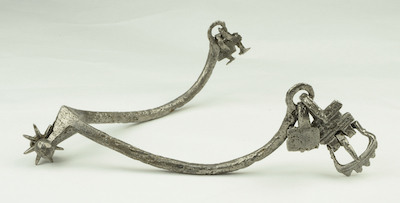
Italian Close Helmet circa 1580
One-piece skull, visor, upper and lower bevor and 3 neck lames front and back. The skull rising to a tall roped comb (small holes near the top of the comb and one small brazed repair) swept slightly back, bordered by incised lines, with circular holes over the each ear in the form of a circle of 8 holes with a central hole. With a shaped plume-holder incised with chevrons at the base by one rivet on each side. Pointed visor with horizontal vision sight divided centrally, pointed lifting-peg fitting into the upper bevor. The upper bevor fits the visor exactly, the upper edge curved in at the back of the eyeslot. Pierced with circular breaths in the form of a circle of 8 holes with a central hole (matching the holes in the skull, but forming a larger circle). on the right and pivoted at the same points as the chin-piece. Chin-piece and upper bevor secured by hooks which engage in to flattened pegs pierced with a hole. Face hole of the chin-piece bordered by a roped inward-turned roll. Face edge of the skull plain with single engraved line. Lining rivets around the face hole flush on the outside. Three neck-plates at front and rear (lower two rear plates replaced), the bottom ones each with turned and roped border and an additional roped ridge parallel to the border. Similar to the helmet on B-13 from Mantova. Displayed as part of Allen item number A-114.
Weight: 6 pounds 11.2 ounces (3,045 g).
Thickness: Ventail .040-.070 mostly .045-.055. Variable from one spot to the next. Skull mostly .035-.045 in the back and sides, thicker in front. Still quite variable but larger areas .050-.070. Bevor mostly .045-.060 with a few spots on the left side up to .09. In general relatively thin and quite variable. [inv. num. A-114a]

Breastplate late 15th c.
Built in the characteristic 15th c. style of 2 plates where the upper plate covers much of the chest and is overlapped by a lower plate that rises up in the center. The upper plate has simple, tapered, outward-turned rolls at the neck and arms. The roll at the neck is just slightly curved. There are two rivets for attachment of buckles at the shoulders, both of these are replaced, one has been moved somewhat to account for the loss of the end of the shoulder extension. There is another rivet right at the edge of the loss that matches the location of the rivet on the other shoulder. The lower plate has a flare at the bottom for the suspension of a fauld. There are 2 holes for the rivets to secure the fauld lames, a rivet remains in one hole. The 2 plates are presently secured by 4 rivets, the largest, central one of these would have originally been a bolt, the others are later additions. The lower plate rises to a wide peak at the center and it cut with 2 small cusps at the side. The edges of the central point are beveled over most of the edge. The bevel terminates before the cusps. This breastplate is of relatively heavy construction. The metal thickness by visual inspection in the center appears to be app. 3 mm tapering to app. 1 mm at the sides. These are estimates as it is hard to actually measure the thickness in its current configuration. A few actual measurements with a deep micrometer indicates that after the losses to rust the central upper breastplate varies between .115 and .150 in. in the center. The edge under the arm thins noticeably - the very edge is generally .040-.050 with one thin spot down to .030. Within 2 in. from the edge it thickens to .090 and then on up to the central thickness. The lower plate is more even in thickness and noticeably thinner - generally app. .050 in. It is basically a really large waist lame. There is some loss to one shoulder and at the center of the lower flare.
A very similar breastplate is illustrated as item 5.8 (page 89) in The Medieval Armour from Rhodes by Karcheski and Richardson. This item is in the collection of the Chateau de Grandson Switzerland. This breastplate is described as German or Italian end of the 15th/early 16th century. They also identify it as of the type called Fussknectbrust - for use by armoured infantry. This one may be intended for mounted or higher-end use since the metal thickness varies from the center to the sides. Generally these simple 2 piece breastplates are attributed to late 15th c.
Measurements: (all taken straight on the inside) - width at the narrowest spot between the armholes - 9 1/2 in., width at the bottom of the armholes 14 3/8 in., width at the waist 12 1/4 in., height from waist to the top of the center of the neck 13 7/8 in., overall height 15 1/4 in.
Weight 6 pounds 10.6 ounces (3,025 g). [inv. num. A-193]

Italian or Flemish Breastplate circa 1500
Formed of a single piece with a medial crease, flared bottom edge and large triangular rolls at the arms and neck. The roll at the arm with engraved/filed decoration in the form of lines. There are a set of holes on the right side for the attachment of the pins for a lance rest. This is a fine example of a rare type of breastplate made at the turn of the 16th century. Examples like it may be found in the Waffensammlung Vienna, Metropolitan Museum NY, another in the current collection - Allen item number A-321, etc. For a very similar example see Kienbusch Collection in the Philadelphia Museum of Art #1977-167-132 formerly in the Dean collection.
Size measurements: Width of neck hole - 8 1/2 in. Height of arm hole - 9 in. Arm hole to waist- 4 1/2 in. Center from top of roll to waist - 12 3/4 in. Waist flare - 3/4 in.
The metal varies in thickness. Within an inch it can vary about .01 inch. All measurements in inches. Thickness measurements:Sides - .028-.052 - mostly in the .030-.040 range. Upper area between arm and neck (right side) - .035-.050.Mostly around .040. Same thing (left side) - .059 - .075 (thicker than the other side). At the lance rest holes - .040 - .052. At the top crease area - .070 - .080 (mostly .080). At the center near crease - .080 - .11. Center near the waist - mostly .040 - .050. Height of upper roll at the center (measured with a gauge from the back of the material)- .66. Max height of right arm roll - .84. Max height of left arm roll - .71. Measuring from the front of the breastplate the rolls height and width at the widest spot are: right 3/4x13/16 inch, left 11/16x3/4 inch, neck 11/16x23/32. To generalize, the armourer was aiming for a roll about 3/4" high and about the same in depth (19mm). [inv. num. A-66]
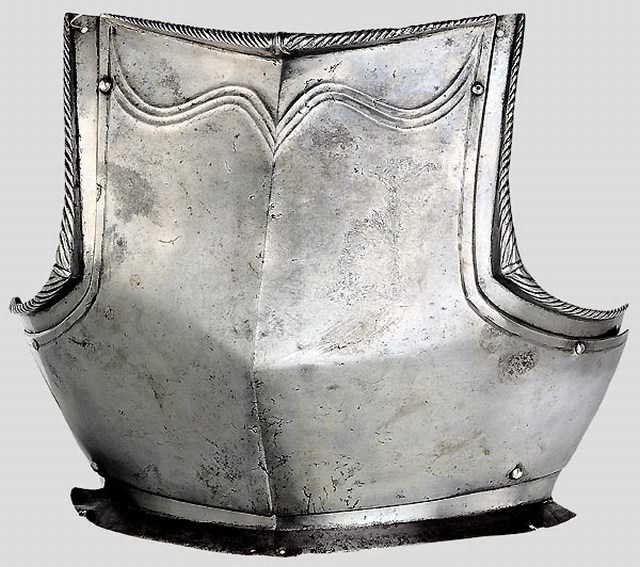
Lower-German Breastplate circa 1550-1560
Heavy hammered polished iron breast plate with strong projection in the medial ridge and triple extruded curved V-lines under a centrally subdivided roped flange. The left side etched (faded) with a crucifix and kneeling knight. Inset gussets with high roped turnovers. Riveted waist lame. The arm holes are bordered by a narrow recessed band. The bottom edge heavily beveled with a decorative notch at the center. The inside with distinct tool marks, the iron slightly raised in places, the double holes for the lance rest filled in the distant past. Rivets replaced.
Height 12 1/2 in. (32 cm). 11 1/2 in. wide at the waist, 15 1/2 in. wide under the arm holes. 11 1/2 in. wide at the top with the gussets fully extended.
Thickness on a line from the center point to the central point of the left arm roll .156 in. up to .210 app. 1 1/2 in. from the center to .170 at the corner. Along a line 1 in. up from the bottom edge from the center to the outside .160 in. at the center thinning down to .10 at the rivet securing the waist lame down to .075 near the edge. Upper half more consistent ranging somewhat randomly between .170 to .210 with a few spots reaching .230. Up at the top corner of the arm hole thining down to .120 in. Waist lame in the upper facet .132 in. near the center tapering to .055 in. at the edge 'Flair' less even and generally thinner varying between .110 in. to .045, mostly between .070 and .090 in. Overall pattern .20 thick near the center, tapering to .070 at the sides and .150 at the top. [inv. num. A-61]
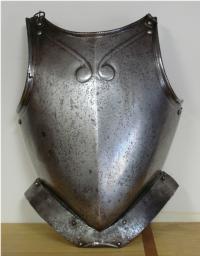
Italian Breastplate and Backplate circa 1580
Breast-plate of deep peascod form with medial ridge and two embossed volutes at the top, armhole gussets, single plate skirt, and later fixed lance-rest (removed). Tall inward-turned, finely roped rolls at the neck and armholes. The armholes on the main plate have a line incised parallel to the edge. Fauld lame with incised line parallel to the upper edge and inward-turned roped roll central arch. Steel buckles at the shoulders. Back-plate shaped to the back, embossed with rounded ribs in the form of a 'V' towards the top and parallel to the arm holes. With incised vertical line at the center. Inward-turned, roped rolls at the neck, arms and on the edge of the narrow waist flare. Breast of heavier form, consistent with those made for cavalry use. Breast and back associated. Similar to those on B-13 from Mantova. Displayed as part of Allen item number A-114.
Breastplate - height 15 from base to center to neck hole. Width 10 in. at the waist and 13 1/2 in. under the arms. Neck roll 1/4 in. wide and 3/8 in. tall at the center. Backplate - height 14 3/4 in. width under the arms 14 3/4, 10 1/4 in. at the waist. 11 1/4 in at the upper edge.
Breastplate - thickness at the outer edge .035 at the upper corner under the arm to .080 near the waist. At the holes for mounting the lance rest .075-.110, primarily in the .080-.095 range. Center .110-.130 in. Upper area thins to .055 in. at the upper corner, but generally .070-.085 in. Peascod thins to .055 at some spots, but generally .065-.080 near the center. Overall, the center is app. .125 in. thick, tapers out to .070-.080 in. at the sides before thinning to app. .060 in. very near the edge and top. Backplate - varies between .022 in. and .060 in. Most of the area is .030 in. to .040 in. Thickness is much more variable. It does not seem to be intentionally thickened in any specific area. [inv. num. A-114b]
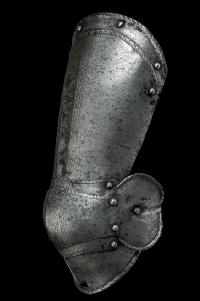
Cuisse with poleyn circa 1580
Comprising a one-piece cuisse with poleyn of 4 plates. The cop of deeply rounded form with a small wing. The edge of the cop rises to a point at the center, the outer edge of the lames are cut to form a point in the center and points over the rivets. The top edge of the cuisse, wing and bottom plate with inward-turned rolled roped edges. The rolls are fairly even, the one on the top of the cuisse does taper a little bit. The rolls on the edge of the cop wing are full rolls on the flat portion of the wing but they flatten out and finally disappear in the indented area. The cuisse is shaped to the thigh, creased at the center and has an additional raised and roped line parallel to the top edge. The leg has a band of etched decoration in the form of a set of trophies of armour flanked by roped bands along the center line. The band between the top roll and roped line is etched with a foliate design. The edges of the cop and lame are filed with a simple roped decoration and have notches at the center crease. There are single filed notches on the inner ends of the cop, lame, lower plate and cuisse. The image of the leg with the knee bent illustrates the extent of motion allowed by the armour (almost, it does move a little more under pressure). Strap mounting rivets remain near the top of the cuisse and on the cop. The lower lame has a central slot to be secured to the greave.
Height 14 1/4 in. tall.
Generally varies between .030 and .050 inch thick, mostly .035-.040 in. with some places where it is as thin as .020 in. on the lower plate. [inv. num. A-169]

Spaulder plate circa 1510
Main plate from a left spaulder. Nice shape swelling at the top. Central vertical crease. Upper edge with a recessed band as a decorative (and stiffening) border. A single hole for a buckle at the center of the top. 3 holes for attachment of the other plates - one near the back corner for a sliding rivet, the other two at the center and front, placed higher for the attachment of leathers.
4 3/4' tall, 6 1/4' wide at the widest point.
.028-.038' thick. Generally slightly thinner at the middle. [inv. num. A-56]

Spaulder circa 1530
Possibly Landshut. Formed of 6 plates, the 2nd overlapping the first and the lower plates. Fluted overall in 4 sets of 3 flutes each. Bands separated by flat areas etched with running foliage and a bird a female figure. The top plate with a plain turn and recessed border which continue onto the to of the second plate. The next 3 plates with plain ends. The final plate with a heavily roped inward-turned roll on the bottom edge and a pair of horizontal flutes. All flutes accented with parallel engraved lines, one on each side of the flute. Retaining its original buckle at the bottom front corner of nice form. Ex. Coll. Dr. John Waldman. 10 3/8 in tall. 1 ound 5.8 ounces (615g). Thickness .030-.050, mainly closer to .040. [inv. num. A-147]

Italian Pauldron late 16th cent
Large main plate overlapping those above and below. 2 plates above, 4 below. Main edges with inward-turned rolls and recessed borders. For use with a floating elbow or with elbow gauntlets. Brass-capped rivets. Leathers and some rivets replaced. Top plate cracked at the center with a modern riveted patch.
Thickness varies between .022 and .058 in., mostly .035-.040 in. There seems to be very little pattern to the thickness variation. There has certainly been some loss due to oxidation.
Measurements: height at the crease measured over the outside 12 1/2 in. length of the top of the main plate 17 3/4 in. (9 behind the crease, 8 3/4 in front).
Weight: 1 pound 13.6 ounces (840 g). [inv. num. A-35]
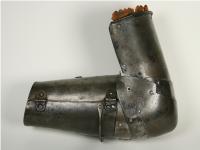
Arm circa 1430
Extremely rare example of a 15th c. piece of armour. Arm for the left arm. Perhaps from the fortress at Chalcis (Negroponte). Formed of a tubular upper cannon that wraps two thirds of the way around the arm connected to a bluntly-pointed cop with an abbreviated wing by one lame. The cop is then connected to a tulip-shaped vambrace formed of two pieces hinged on the outside by hinges and secured by a strap and buckle on the inside. The cop is connected to the vambrace by two lames. The second lame is attached to the vambrace by means of 3 lateral slots allowing the arm to rotate. The lower edge of the vambrace is bordered by a line of small rivets. The lower cannon is marked by an indistinct maker's mark involving a split cross. The upper edge of the upper plate with a narrow, outward-turned roll and a line of rivets securing a (later) leather used to lace the armour to the arming doublet. The inner plate of the vambrace, one lame, lisiere d'arret, one half of one hinge, and all of the rivets replaced. The character of these restorations is similar to the restorations on the Rhodes pieces in the Royal Armouries. Given Claude Blair's association with the Royal Armouries and the presence of the letters HRR on the inside of the inner vambrace plate it is likely that this piece was restored there (HRR almost certainly represents H. Russell Robinson). From the personal collection of Claude Blair. For similar examples see Stephen V. Granscay, The Bashford Dean Collection of Arms and Armour...., 1933, nos. 76-81, pl. V. The most detailed record of the pieces discovered at Chalcis see C. J Ffoulkes, An Italian Armour from Chalcis in the Ethnological Museum at Athens, Archaeologia, LXII (1911) pp. 381-390.
Measurements 39 cm long. The arm is 15 in. long overall when straight, upper cannon 5 1/2 in. tall at the center of the cop, 4 5/16 in. wide at the top, 4 3/16 in. wide at the bottom. The upper cannon is 8 1/8 in. around the circumference. The roll at the top of the upper cannon is 1/8 in. tall and 3/16 in. deep. Lower cannon 7 1/4 in. long at the center of the cop, 3 7/8 in. wide at the elbow, 2 5/8 in. wide at the wrist. The cop 3 1/4 in. tall at the center, 2 in. tall at the wing, 1 1/2 in. tall at the back. The slots in the vambrace for rotation are 5/8 in. wide. The hinges are 3/4 in. wide, the upper one is 1 3/8 in. long. The inside measurements of the buckle are 3/4 in. on the wide side of the trapezoid, 5/8 in. on the short side and 5/16 in. tall. The thickness varies significantly. The upper cannon is .040-.090 in., mostly .050-.070 in. The thickest part in the center. The cop is .050-060 on the back and .070-.080 on the front. The outer plate of the lower cannon is generally .070-.080 in the upper center and .050-.060 near the wrist. The upper lame is app. .030 in. and the lower one .040 in.
Weight 2 pounds 7.2 ounces (1,110 g). [inv. num. A-186]

Arm harness circa 1540-60
Formed of an upper and lower vambrace articulated by means of one lame below and one lame above to the bracelet cop. The upper vambrace includes a turning collar which was originally directly attached by a sliding rivet at the back and two leathers to the pauldron. Rolled and roped borders at the wrist and on the edge of the wing. Simple outward rolls at the inner edge of the upper and lower vambraces (at the elbow). Elbow of very pointed form with full bracelet wing. Horizontal raised and roped ridge on the outside from the point of the elbow to the center of the wing. Iron rivets with brass caps articulating the plates and attaching the hinge for the lower vambrace.
Turning collar 4 3/4' in diameter. Lower vambrace 9 3/8' long at the longest point.
Upper cannon .030-.050' thick, lower cannon more even .030-.040' thick. [inv. num. A-27]
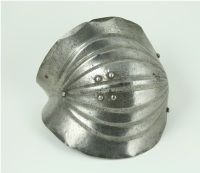
Two couters circa 1490
A pair of elbows - one is authentic, the other a well made copy. Each of shell form, pointed at the outside of the elbow and with a flare at the inside of the bend of the elbow. The outer surface covered by three stepped flutes on each side and a central squared raised ridge. Each of these is accentuated by an engraved line at the base of the step. The outer edge is decorated by a series of five cusps. The back and inside of the wing are plain. The cops have modern straps and have four holes at the center to secure the cop to the arm. Four holes are usually indicative of laces, but these holes appear to be smaller than would be normal for this. The form, decorative elements and four holes indicate a late 15th century date for the elbow.
Measurements: Elbow thickness varies significantly reflecting the rough interior surface - a few thick areas app. .060, thin areas app. .030. Varies significantly even in spots close to each other often between .040 and 050 in one area of the center. It appears this elbow was shaped roughly and ground to its smooth surface, not hammered to the exact shape.
Weights: elbow: 7.4 ounces (210g). [inv. num. A-214]
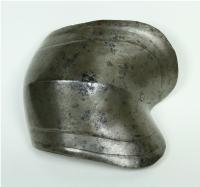
Couter (elbow cop) circa 1500
Formed in a single piece wrapping two thirds of the way around the arm. With a raised ridge bordered by a parallel recessed border around outer edge of the wing and front of the cop, each accented by an engraved line. One rivet at the center to secure a leather connecting the cop to the vambrace and rivet and hole to secure a strap around the elbow. The cop formed with a blunt medial ridge forming a shallow point. This elbow is formed in a plain style that may be of either German or Italian origin. From the personal collection of Claude Blair.
Measurements 18.5 cm wide. 6 5/8 in. tall at the widest part of the wing, 5 in. tall at the back edge, and 6 in. from the point of the center of the wing to the back edge. Thickness .050-.080, generally in the .060-.075 range. [inv. num. A-185]
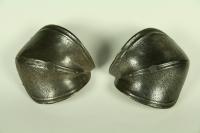
Pair of Elbow cops circa 1500
German. A pair, both pitted, one with a large internal patch. Each of small, shell form with fluted border and engraved lines. Rising to a central fluted ridge, also accented by engraved lines. There is a hole in the center which would have engaged a pin in a leather strap that connected the cops to the vambrace. There are also two rivets at the back and one in the wing to secure a strap across the inside of the elbow. Ex. Col. Dr. Peter Parsons.
Measurements 5 1/4 in at the widest spot, 4 3/4 in. from the inside of the back to the inside of the inner point of the wing. The central hole is 7/16 in. in diameter. Thickness varies between .040 and .070. Generally thickest about 1/2 in from the center ridge flowing up to the point, thinning toward the central crease and toward the edge. Most of the area in the back, wing and outer edge is .040-.050. [inv. num. A-199]

German floating Elbow circa 1510-1520
Simple 'Maximilian' form. Rounded flutes accented by engraved lines. The elbow covers the outer two thirds of the elbow. It represents an example of a somewhat lower quality elbow than is normally displayed on armours in public collections. The elbow would have been secured to the arm using a leather strap between the upper and lower arms and a strap around the elbow.
2 nearly identical elbows are in the Fitzwilliam collection (no.s HEN.M.135A-1933 and HEN.M.135B-1933) identified in the catalogue by Ian Eaves as 1510. Another set is displayed in the Art Institute of Chicago (part of infantry armor dated 1510-15 inv. 1982.2427b-f). Another similar pair is displayed on the suit displayed in the Cleveland Museum of Art lent by the Board of Trustees of the Royal Armouries Inv. II.143 37.2008. From the R.T. Gwynn collection (Lot 65 from the 2001 Christies sale of the Gwynn collection). Previously purchased by R.A. Lee as lot 40 from the Christies Arms and Armour sale Dec. 17, 1968. 6 1/2 in. tall. Thickness .030-.050, generally around .040. 9 oz (255g). [inv. num. A-58]

Gauntlet finger circa 1370-1400
English. Three finger plates from a fourteenth century English gauntlet, most likely an hourglass gauntlet. Comprising the first, knuckle and second plates. Main plates decorated with raised ridges at the center bordered by pairs of engraved lines. First plate with slightly domed areas at both ends bordered with a lightly engraved line. Third plate with a slightly domed area at the front that is bent down slightly. Knuckle of domed form with a raised ridge the edges with an engraved line parallel to the edge with plain file decoration like simple roping. Each plate with two rivets to secure them to the foundation arranged down the length of the main plates and on the sides of the knuckle plates. Made of iron. Old, mostly stable oxidized finish on the exterior. Found at Queenhithe, London. Publications: Object and Economy in Medieval Winchester Martin Biddle (Fig 349) Medieval Artifacts Nigel Mills. (Fig 245b) and Armour of the English Knight 1400-1450 by Tobias Capwell page 166 - illustrated along with several separate gadlings in private collections.
Measurements: First plate 2 3/32 in. long, 1 3/32 in. wide at the back end, 7/8 in wide at the front (measured at the very end before the corners are beveled back). Knuckle 1 3/16 in wide, 31/32 long at the side, 15/16 at the center. Third plate 1 3/4 in. long, 1 in wide at the back and 7/8 in wide at the line demarking the shaped area at the end where it starts tapering more. All width measurements performed flat under the curved plates. Thickness: generally .040-.050 with some thick spots up to .060 in.
Weight: [inv. num. A-236]

German Gauntlet (part) circa 1490-1500
Finger, knuckle and 1 1/2 metacarpal plates of a German Gothic mitten gauntlet. The finger lames are fluted so simulate fingers, the knuckle plate with rounded and creased knuckles. The first metacarpal plate is fluted with v-shaped puckers to accommodate the flutes in the knuckle and finger lames. There is half of the hinge used to attach the thumb plate, and half of the second metacarpal plate remaining. Each of the articulations is formed with sliding rivets with slots app. 1/4 in. long. 2 rivets have been lost, the parts held together by bolts. Formerly in the collection of Leonard Heinrich - armourer to the Metropolitan Museum of Art, NY.
Thickness: Generally around .030 in. The back of hand plate is pretty consistently .028-.032. The knuckle plate varies more, generally .025-.030, the finger plates vary even more - .020-030. The hinge is folded over. The overall thickness of the two layers is .060 at the bend, the actual metal is likely a little thinner. The pin is .090 in diameter, the hinge is .450 wide at the pin. The partial plate is 3/4 in. wide at the center, .7 in. at near the bulge at the end, .85 at the bulge for the rivet. The second finger plate is just over 1 in. wide. The first plate is app. 1 1/16 in. wide. The main hand plate is 2 in wide at the first knuckle tapering to 1 11/16ths at the fourth knuckle.
Weight: 4.6 ounces (130 grams)
There are often questions about how the flutes can work through the range of movement, esp. where the knuckles interact with the metacarpal. The last two images posted show the interaction between the metacarpal and knuckle plates when the hand is straight and when the sliding rivets are fully compressed and fully extended. These show that they really don't work all that well when fully compressed and straight. They do look and work pretty well when somewhat bent and extended. This is just sort of the nature of movement when one plate has tapering flutes. [inv. num. A-47]

Gauntlets circa 1480-90
Gothic Gauntlets. Nicely formed 'Gothic' gauntlets typical of the late 15th century in Germany. Fluted, engraved and pierced overall. Formed of a large metacarpal plate joined to a wrist lame by another, smaller lame. The cuff is also attached to the wrist lame. These plates are attached with sliding rivets allowing the wrist to flex in all directions. The knuckle plate is formed into a blunt point over each knuckle. The fingers are covered by 4 articulated plates fluted over each of the fingers. These gauntlets have been cleaned and re-assembled, but they are basically a complete pair of gauntlets. The thumbs have been restored and the left cuff is associated.
Thickness varies .020-.033 in. Generally thinner in the cuff and back of hand.
Measurements: 14.75 in. long with the slots extended, 13.875 in. long with the slots collapsed, 12 in. from the point of the cuff to the knuckles (with the slots extended and the hand drooped), 5.125 in. from the knuckles to the end of the fingers (with the fingers fully bent), 3 in. wide at the wrist, 4.875 in. wide at the knuckles, 3.56 wide aat the end of the cuff, width of the fingers at the rivets on different plates tapers from 3.875 in. down to 3.625 in. All measurements on the right gauntlet. [inv. num. A-98]

Mitten Gauntlet late 16th century
Of russet steel. Hand formed of 5 overlapping plates articulated to allow the wrist to bend down and up. Fingers covered by mitten plates formed of 5 separate plates, the final one with a narrow, inwardly turned, roped roll. Hand joined to the fingers by a roped knuckle plate. Cuff of slightly tapered tubular form made from an inner and outer plate. There is a small roll on the inside of the elbow. This was most likely intended to be used without a vambrace as a simple elbow gauntlet. The end of the cuff has a line of rivets to secure a leather strip, the terminal finger plate has a line of rivets to secure the glove and there are remains of a palm strap secured to the main hand plate. Half of the hinge for the thumb remains. The articulations on this gauntlet are very well executed. The rivets appear to be original. From the George F. Harding Collection, previously ex collection Henry Griffith Keasby. 14 5/8 in long. Thickness - cuff .030-.042 back of hand .040-.050 fingers .025-.040 primarily around .032. Close inspection of the finger lames shows the center of the lames are 1.1-1.3 in. wide, the thumb side at the bend are just under an inch and the other side app. .93 in. Rivet tabs are app. .2 in. Weight 1 pound 4.8 ounces (585 g) [inv. num. A-122]

Gorget circa 1560
South German, probably Augsburg. Of bright steel composed of 4 plates front and back. The top one with inwardly-turned and roped roll, the bottom one drawn down to a blunt point in the front. Hinged on the left side with an integral hinge in the top collar plate and a rivet in the main plates. Secured by a rivet on the rear plate engaging a keyhole in the front plate and two pins engaging holes in the upper plate on the right. Two pins are relatively rare. This may be to keep the upper plates aligned perfectly if the collar is meant to engage a roll on the bottom of the helmet. The upper one is secured to the rear plate and engages a hole in the front plate, the lower one is secured to the front plate and engages a hole in the rear plate. The top corners of the second rear plate are notched to allow the gorget to open, the plates to fit nicely and still allow for an overlap. With brass-capped rivets throughout. The rivets that secure the straps for the pauldrons are modern. The other rivets may be original, which would make the leathers original. Possibly some form of mark on the main front plate. Very nice form with tapering neck plates. The gorget includes two straps for securing the pauldrons which appear to be later replacements. Details of the contruction including the difference in thickness between the front and back plates, the double pins, beveled edges, inset hinge, brass capped rivet heads and finished edges of the inner plates indicate this likely formed part of a high quality armour. This is very similar to the gorget on Wallace A45 catalogued as A45.02 and WAM 2014.1175.2 formerly in the John Woodman Higgins Armory Collection. The leathers are old and collapsed so the images do not show the plates sitting as they should. The gorget should be much taller.
Ex. Coll. Peter Parsons (2011), Robin Wigington (1977), Part of a South German armour sold by Sotheby , Co. London 12 Feb. 1974, lot 172.
10 3/4 in wide at the back, 8 3/4 in wide at the front. Thickness varies on the front main plate between 0.070 in. and 0.095 in. It is generally in the 0.080 in. range. The main rear plate is thinner - 0.040 in. to 0.055 in, mostly .040-050.
Weight: 2 pounds 8 ounces (1,130 g) [inv. num. A-201]
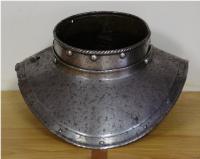
Italian Gorget circa 1580
Gorget of two main plates with single neck-lames at the front and rear. The outer edges of the main plates are bordered by a half roll and recessed border, the half roll roped. The neck edge of the main plates with matching roped half-rolls. The neck plates with roped full rolls. The neck plates are secured by an internal hinge at the left and a pin in the rear plate engaging a hole in the front plate on the right. The main plates are secured by a turning hook on the right which engages in a keyhole slot. Very similar to that on Corselet II.47 in the Royal Armouries (illustrated on plate LIX in European Armour in the Tower of London). Displayed as part of Allen item number A-114.
Measurements: Top of collar 6 in. wide and 6 3/16 in front to back. 11 1/4 in. wide at the widest part of the back. Thickess of the main plate generally .030-.040, the collar plate .020-.030. Weight 1 pound 9.6 ounces (725g). [inv. num. A-114c]
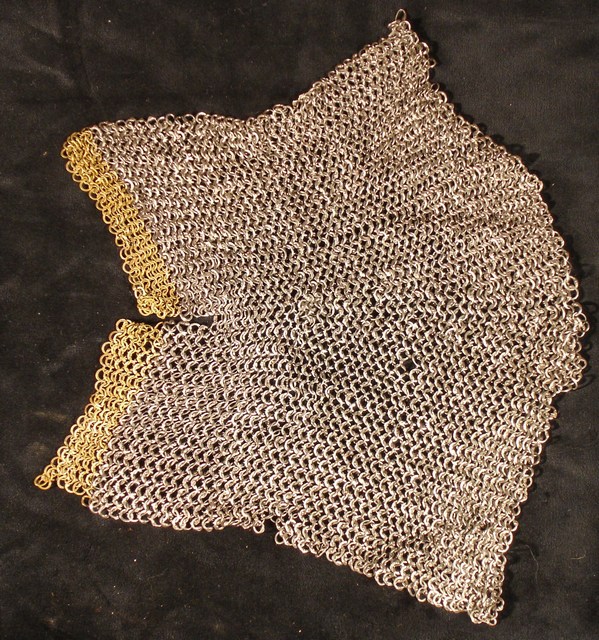
Mail Voider 16th century
For the right arm. Rings of somewhat flattened form. Rings averaging app. 7 mm outside diameter. Overlap in the form described as pent roof on both sides. Wedge rivets. Tapered with expansion under the arm to accommodate the shoulder. Wider across the back. labeled as German. The pent roof shape of the overlap is associated with German manufacture. Small brass borders of alternating solid and riveted rings eleven rows wide (6 solid, 5 riveted.). The solid rings flat, the riveted rings of round section. Wedge rivets. Border is secured by a line of flattened butted rings indicating that it was almost certainly added after the working life of the piece. App. 9 in. wide at the cuff, 9 in. long at the edges, 10 in. long at the center and 15 in. wide at the base.
Detail images over the scale show the outside and inside of the rings. Microscope images show: first and second show a broken ring where the rivet has held, though the top of the overlap has partially torn free, third shows striations (possibly from punching) on the solid latten rings of the edging, fourth shows draw marks on the riveted latten rings and burring on the punched rings, fifth shows the back of the brass wedge rivets and more striations on the punched rings, sixth shows the shape of a rivet hole in the latten rings - a trapezoid similar to a sharp-cornered USB connector. Detailed images and analysis by Mart Shearer. [inv. num. M-4]
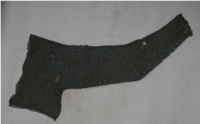
Mail Sleeve 16th century
Formed of small rings with app. 7/32 inch inside diameter measured with a ruler. Wire thickness measured with a dial gauge app. .030 in. OD of rings app. .270 varying noticeably as many of the rings are slightly oval. For these rings the ID would be app. .210 inch or 5.4 mm. This is consistent with the rough measurement. The sleeve includes an area covering the shoulder and armpit, full sleeve with bend at the elbow and tapering to the form of the arm. Rings of rounded section with flattened area for the rivet. All rings riveted. Wedge rivets with the back set flush and front forming a a shallow point. Rings of consistent size. No signs of decorative rings at the edge of the gusset. There are a very few remaining rings that are likely brass at the cuff. Small losses, but relatively sound. Missing rings have been replaced with butted rings to stabilize the fabric. The total surface area is 564 sq. inches, given the density of the mail this means there are app. 18,340 rings in this sleeve. It weighs app. 3 lb. 5 oz. (1500 g). The sleeve is tailored using a line of reductions on the upper arm running in a line from near the corner of the cross-grain joint of the armpit to a place just shy of the elbow. It also has two lines of row reductions in the forearm. This sleeve is larger than the other one and less dense. Analysis, repairs and marking by Robert MacPherson.
Detail images show the edge of the shoulder area over an inch scale. Microscopic images show: first a missing rivet in the iron rings with a trapezoidal hole, second shows a missing rivet in the latten cuff. The cusped edge on the solid latten ring is generally considered evidence of punching too close to the edge of a previous hole. Detailed images and analysis by Mart Shearer. [inv. num. M-15]




